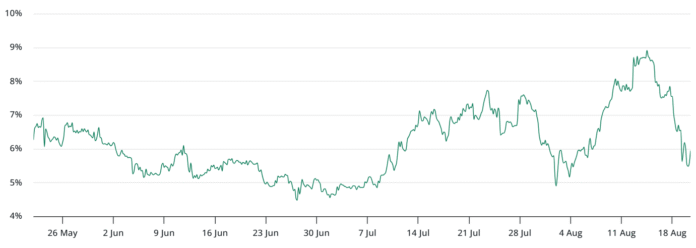Ether (ETH) has found support at $4,070 after a sharp six-day decline of 15.1%, which wiped out $817 million in bullish leveraged positions. However, this move did not trigger a widespread bearish shift, and instead, ETH derivatives indicate that traders are unimpressed by the additional downside, suggesting that $4,700 remains within reach.
The annualized futures premium of ETH remained above the neutral threshold of 5% during the decline, signaling trust. The monthly futures are usually higher than spot markets to reflect the longer settlement period, but the last meaningful bullish signal of this metric came in January. Even the 100% ETH rally between July 1 and August 13 could not completely restore trader optimism.
Economic Uncertainty and Investment Mood
Part of this hesitation is based on macroeconomic uncertainty, with US inflation remaining above the Federal Reserve’s 2% target, while economic growth shows uneven signals. The Nasdaq Composite fell on Wednesday for a second session in a row, pressured by concerns that artificial intelligence stocks could be overestimated. CNBC reported that traders have tailored positions ahead of US Federal Reserve Chairman Jerome Powell’s speech on Friday, with Carol Schleif, chief market strategist at BMO Private Wealth, stating, “If Powell’s language is more hawkish, this could put tech shares under even more pressure.”
In contrast to expectations, ETH options indicate a neutral attitude, with demand for downside and upside protection balanced. The current 4% reading shows an even division between put (sell) and call (buy) interest. However, the lack of stronger optimism is somewhat worrying after ETH traded above $4,700, as traders hesitate to call a new all-time high.
Onchain activity paints a more constructive picture, with Ethereum extending its dominance over competitors and securing around 60% of the total value locked (TVL) in the market, according to Defillama. More importantly, network fees are increasing, reflecting greater demand for block space, which supports the price recovery of Ether.
Ethereum’s 7-day fees rose to $11.2 million on Wednesday, a 38% increase compared to the previous week. For comparison, Solana’s fees only increased by 3%, while the income from the BNB chain decreased by 3%. This divergence highlights Ethereum’s dominance in decentralized exchange volumes, which reached $129.7 billion in the last 30 days, according to Defillama.
Conclusion and Market Outlook
While Ether traders still interpret caution, this attitude rather reflects the wider crypto market correction than Ethereum’s fundamentals. Traders seem cautious due to US import tariffs weighing on global growth and investors potentially urging risk aversion. Ultimately, the path for ETH to regain $4,700 is a decline in investor fear about the economy. However, derivative data indicates that professional traders remain calm and do not show signs of panic, even after the retest of $4,100, supporting the case that Ether’s recovery is based on firmer ground than many initially assumed.
This article serves general information purposes and should not be regarded as legal or investment advice. The views, thoughts, and opinions expressed here are solely those of the author and do not necessarily reflect the views and opinions of Cointelegraph. For more information, visit https://cointelegraph.com/news/eth-futures-data-reflects-traders-fear-while-onchain-data-points-to-a-price-recovery?utm_source=rss_feed&utm_medium=rss_category_market-analysis&utm_campaign=rss_partner_inbound

